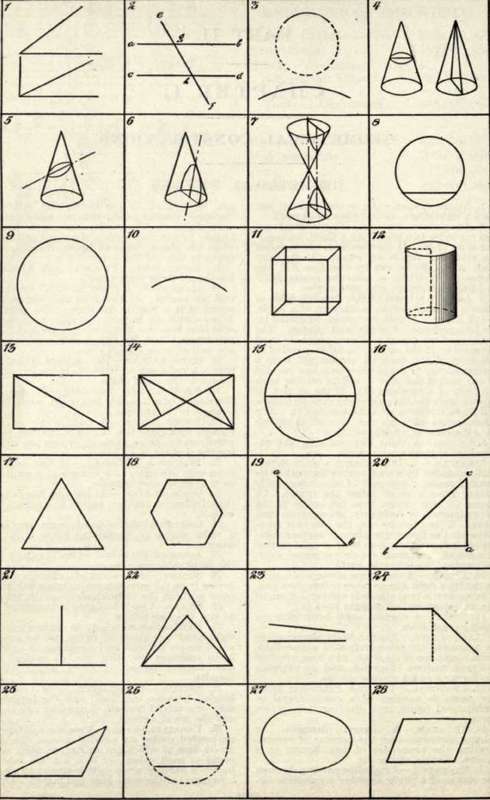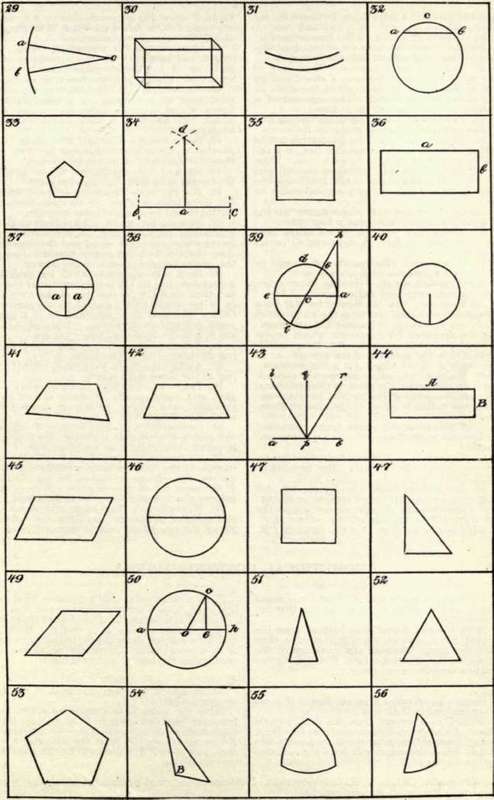Geometrical Figures
Description
This section is from the book "Scientific American Reference Book. A Manual for the Office, Household and Shop", by Albert A. Hopkins, A. Russell Bond. Also available from Amazon: Scientific American Reference Book.
Geometrical Figures
1. Acute Angle
An acute angle is less than a right angle, or less than 90 degrees.
2. Alternate Angles
The internal angles made by two lines with a third, on opposite sides of it. If the two lines are parallel, the alternate angles are equal. If the parallels AD, CD, be cut by the line EF, the angles Agh, Ghd, as also the angles Bgh and Ghc, are called alternate angles.
3. Arc
Any part of the circumference of a circle or other curve; a segment of a circle.
4,5, 6, and 7. Conic Sections. - Formed by the intersections of cones and planes. The conic sections are the ellipse, parabola, and hyperbola. If the section be taken parallel to the base of the cone its outline will form a perfect circle. If the section be taken parallel to one side of the cone it will in outline have the form of a parabola (6). If the section be taken parallel to the axis of the cone its outline will have the form of a hyperbola (7). Any other section through the cone will in outline have the form of an ellipse (5).
8. Chord
A right line marking the extremities of the arc of a circle.
9. Circle
1. In geometry, a plane figure, comprehended by a single curve line, called its circumference, every part of which is equally distant from a point called the center. Of course all lines drawn from the center to the circumference, or periphery, are equal to each other. 2. In popular use, the line that comprehends the figure, the plane or surface comprehended, and the whole body or solid matter of a round substance, are denominated a circle; a ring; an orb; the earth.
10. Curve
A curve line is one which may be cut by a right line in more points than one. A curve line is that which is neither a straight line nor composed of straight lines.
11. Cube
A regular, solid body with six equal square sides.
12. Cylinder
A solid body supposed to be generated by the rotation of a parallelogram round one of its sides; or a long, circular body, of uniform diameter, and its extremities forming equal parallel circles.
13. Diagonal
The line extending from one angle to another of a quadrilateral or multilateral figure, and dividing it into two parts.
14. Diagram
A figure, draught, or scheme delineated for the purpose of demonstrating the properties of any figure, as a square, triangle, circle, etc.
15. Diameter
A right line passing through the center of a circle, or other curvilinear figure, terminated by the curve, and dividing the figure symmetrically into two equal parts.
16. Ellipse
In conic sections, a figure formed by the intersection of a plane and cone when the plane passes obliquely through the opposite sides of the cone.
17. Equilateral Triangle
A triangle having all three sides equal.
18. Hexagon
A plane figure of six sides and six angles. If the sides and angles are equal, it is a regular hexagon. The cells of honey-comb are hexagons, and it is remarkable that bees instinctively form their cells of this figure, which fills any given space without any interstice or loss of room.
19. Hypothenuse
The subtense or longest side of a right-angled triangle, or the line that subtends the right angle.
20. Rectangular Triangle
If one of the angles of a triangle is a right angle, the triangle is rectangular.
21. Right Angle
A right angle is one formed by a right line falling on another perpendicularly, or an angle of 90 degrees, making the quarter of a circle.
22. Isosceles Triangle
If two of the sides only are equal in a triangle it is an isosceles or equicrural triangle.
23. Oblique Line
An oblique line is one that, falling on another, makes oblique angles with it.
24. Obtuse Angle
An angle greater than a right angle, or containing more than 90 degrees.
25. Scalene Triangle
One in which all the three sides are unequal.
26. Secant
The secant of a circle is a line drawn from the circumference on one side to a point without the circumference on the other.
27. Oval
A body or figure in the shape of an egg, or of an ellipse.
28. Parallelogram
1. In geometry, a right-lined quadrilateral figure, whose opposite sides are parallel, and consequently equal. 2. In common use, this word is applied to quadrilateral figures of more length than breadth.
29. Sector
A part of a circle comprehended between two radii and the included arc; or a mixed triangle, formed by two radii and the arc of a circle.
30. Parallelopiped
A regular solid comprehended under six parallelograms, the opposite ones of which are similar, parallel, and equal to each other; or it is a prism whose base is a parallelogram. It is always triple to a pyramid of the same base and height. Or a


parallelopiped is a solid figure bounded by six faces, parallel to each other, two and two.
31. Parallel Lines
One line is parallel to another, when the lines are at an equal distance apart throughout the whole length.
32. Segment Of A Circle
That part of the circle contained between a chord and an arc of that circle, or so much of the circle as is cut off by the chord. The segment of a sphere is a part cut off by a plane.
33. Pentagon
A plane figure having five angles, and consequently five sides.
34. Perpendicular
In geometry, a line falling at right angles on another line, or making equal angles with it on each side. Thus if the straight line AD, falling on the straight line BC, make the angles Bad, Dac equal to one another, AD is called a perpendicular to BC.
35. Quadrangle
A plane figure having four angles, and consequently four sides.
36. Rectangle
A four-sided figure having only right angles. A right-angled parallelogram.
37. Quadrant
The quarter of a circle or of the circumference of a circle.
38. Quadrilateral
Having four sides, and consequently four angles.
39. Tangent
In the figure, let AH be a straight line drawn touching the circle Ade at A, one extremity of the arc AB, and meeting the diameter IB produced, which passes through the other extremity B to the point H; then AH is the tangent of the arc AB, or of the angle Acb, of which AB is the measure.
40. Radius
A right line drawn or extending from the center of a circle to the periphery; the semidiameter of the circle. In trigonometry, the radius is equal to the sine of 90 degrees.
41. Trapezium
A plane figure contained under four right lines, of which no two are parallel.
42. Trapezoid
A plane, four-sided figure, having two of the opposite sides parallel to each other.
43. Reflection
In the figure, let AB represent a smooth polished surface, or mirror, and suppose a ray of light proceeding in the direction LP to impinge on the surface at P, and to be reflected from it in the direction PR.
From P draw PQ perpendicular to AB, then the angle Lpq is called the angle of incidence, and Qpr the angle of reflection.
44. Superficies. A superficies consists of length and breadth; as, the superficies of a plate or of a sphere. Superficies is rectilinear, curvilinear, plane, convex, or concave.
45. Rhomboid
A figure having some resemblance to a rhomb; or a quadrilateral figure whose opposite sides and angles are equal, but which is neither equilateral nor equiangular.
46. Semicircle
The half of a circle; the part of a circle comprehended between its diameter and half of its circumference.
47. Square
A rectilinear figure having four equal sides and four right angles.
48. Rectilinear Triangle
One in which the three lines or sides are all right lines, as distinguished from curvilinear triangle.
49. Rhomb, Rhombus
An oblique-angled, equilateral parallelogram, or a quadrilateral figure whose sides are equal and the opposite sides parallel, but the angles unequal, two of the angles being obtuse and two acute.
50. Sine
In the circle Ach, let Aoh be a diameter, and let CE be perpendicular thereto; then shall CE be the sine of the arc CH, or of the angle Coh, and of its supplement Coa. The sine of a quadrant, or of a right angle, is equal to the radius. The sine of any arc is half the chord of twice that arc.
51. Acute-Angled Triangle
One having all three of its angles acute.
52. An Equilateral Triangle
One having all the three sides equal.
53. Polygon
A plane figure of many angles, and consequently of many sides; particularly, one whose perimeter consists of more than four sides.
54. Obtusangular Triangle
If one of the angles of a triangle is obtuse, the triangle is called obtusangular or amblygonous.
55. Curvilinear And Spherical Triangles
If the three sides of a triangle are all curves, the triangle is said to be curvilinear. If the sides are all arcs of great circles of the sphere, the triangle is said to be spherical.
56. Mixtilinear Triangle
If some of the sides of a triangle are right and others curve, the triangle is said to be mixtilinear.
Continue to:


